The Evolution of Hospital Beds: Revolutionizing Patient Care
Hospital beds play a critical role in providing optimal care and comfort to patients in medical facilities worldwide. Over the years, hospital beds have undergone remarkable advancements, transforming from simple structures to sophisticated and technologically advanced systems. This article explores the evolution of hospital beds, highlighting the key features and innovations that have revolutionized patient care.


The Early Years: Basic Comfort and Functionality
In the early days of hospitals, beds primarily focused on providing basic comfort and functionality. These beds were typically wooden frames with simple mattresses and adjustable headrests. While they served their purpose, they lacked advanced features and customization options that are now common in modern hospital beds.
The Rise of Adjustable Features
With advancements in healthcare technology, hospital beds began incorporating adjustable features to enhance patient comfort and facilitate medical procedures. The introduction of adjustable backrests, footrests, and side rails allowed healthcare professionals to position patients appropriately and improve accessibility for caregivers. These beds also featured height adjustment mechanisms, making it easier for patients to get in and out of bed and reducing strain on healthcare staff.
Enhanced Mobility and Patient Safety
Mobility and patient safety became major considerations in the evolution of hospital beds. Bed designs started incorporating wheels, allowing beds to be easily moved within healthcare facilities. This feature enabled swift transportation during emergencies and simplified the process of transferring patients between departments. Moreover, beds incorporated braking systems to ensure stability and prevent unintended movement, reducing the risk of patient falls and injuries.
Pressure Redistribution and Prevention of Bedsores
The development of pressure redistribution surfaces was a significant breakthrough in hospital bed technology. Beds now featured specialized mattresses, such as alternating pressure and foam mattresses, designed to distribute pressure evenly across the patient's body. These surfaces help prevent the development of bedsores and improve patient comfort during prolonged periods of bed rest.
Advanced Monitoring and Integration
The integration of technology and healthcare has brought forth a new era of intelligent hospital beds. Modern beds now come equipped with a range of sensors and monitoring systems. These sensors can track vital signs, such as heart rate, respiration rate, and blood pressure, without the need for invasive procedures. The data collected by these sensors can be integrated into electronic medical records, providing healthcare professionals with real-time information to monitor patients' health and adjust treatment plans accordingly.
Patient-Centric Features
To enhance patient experience and comfort, hospital beds have introduced patient-centric features. These may include adjustable lighting, built-in entertainment systems, USB charging ports, and bedside control panels that allow patients to control bed positioning and access essential amenities without assistance. By empowering patients and enhancing their comfort, these features contribute to improved overall well-being and faster recovery.
Bariatric Beds
The rise in obesity rates necessitated the development of specialized bariatric beds capable of accommodating heavier patients. Bariatric beds have reinforced frames, wider mattresses, and higher weight capacities to ensure patient safety and comfort. These beds also incorporate advanced lifting mechanisms to facilitate patient transfers and provide adequate support during care procedures.
The evolution of hospital beds has transformed the healthcare landscape, enhancing patient care, comfort, and safety. From basic wooden frames to intelligent systems with advanced monitoring capabilities, hospital beds have come a long way. The incorporation of adjustable features, pressure redistribution surfaces, mobility enhancements, and patient-centric amenities has revolutionized the patient experience, contributing to improved outcomes and faster recovery times. As technology continues to advance, we can expect further innovations in hospital bed design, ultimately shaping the future of patient care.

 英语
英语 中文简体
中文简体






